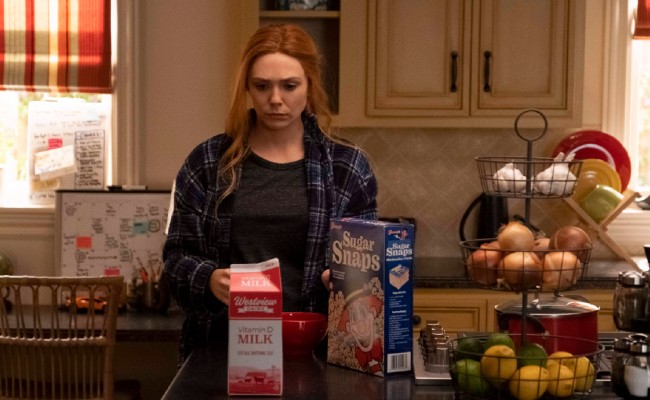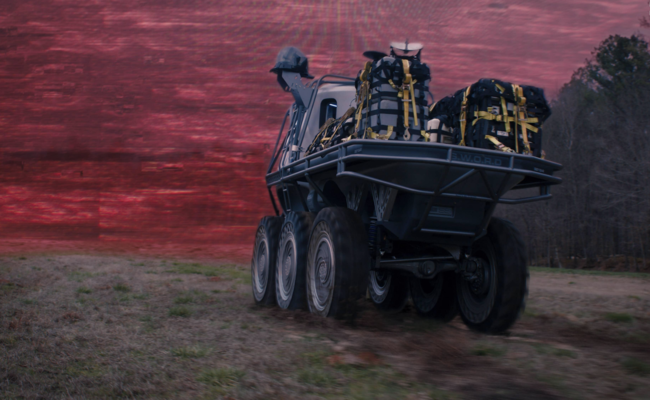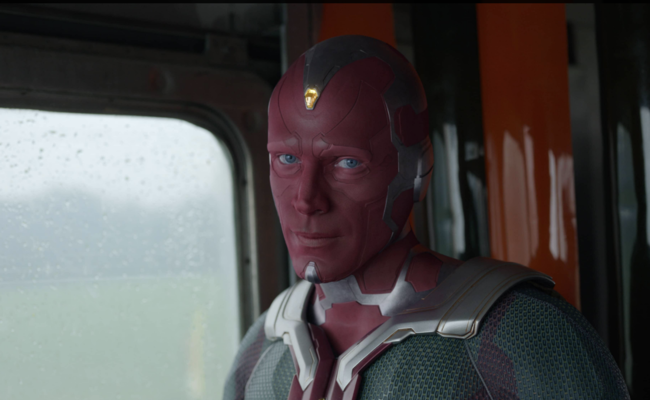SPOILERS AHEAD … AND ALL KINDS OF VERY COOL REVEALS (THE FULL IMPORT OF WHICH DEPENDS ON AN ENCYCLOPAEDIC KNOWLEDGE OF MARVEL COMIC BOOK LORE) …
Holy hiding in plain sight, WandaVision!
Yes, that is an unholy melding of DC and Marvel for which this reviewer will likely suffer death by a thousand Thanos Snaps, but it is appropriate given that we learnt in episode 7, “Breaking the Fourth Wall”, that Wanda (Elizabeth Olsen) is in fact not behind the whole happy suburban anomaly in which she and countless others are imprisoned.
Wait, wait, what, now, you say … how can this be? We have seen Wanda doing all kinds of monumentally massive magical things over the course of the first six episodes, including rather dramatically at the end of episode six, the extension of the shimmering red electric boundary of the Westview anomaly to include a newly-escaped Vision and almost the entire S.W.O.R.D encampment, save S.W.O.R.D. acting director Tyler Hayward (Josh Stamberg), Monica Rambeau (Teyonnah Parris) and FBI agent Jimmy Woo (Randall Park) who outpaced the fast-moving barrier.
She has powers for sure and they are still very much in evidence – although, rather perplexingly for Wanda, they seem to be fritzing here and there, leading to objects in her home switching eras with alarming frequency and unpredictability – but she is not the only in town people!
That’s right! This week, and courtesy of a catchy jingle that was oh-so-hummable (proof that villains do have access to some damn fine singer-songwriters), we found out that good old happy next door neighbour Agnes (Kathryn Hahn) is in fact – Agatha Harkness!
If you are blank of face and cognisantly-challenged about that particular personage, fear not, for this reviewer, not a comic book reader of old, was also a little perplexed at what her unveiling in Westview could mean.
It turns out, it means a LOT.
For Agatha Harkness is a powerful witch who is a former mentor of our very own grief- stricken Wanda, one of the witches from the original Salem with trials and who made her first appearance in Fantastic Four issue #94 way back in the heady days of January 1970.
She is, however, you slice it bad news.
Why she even killed Sparky, the cute as pie puppy that belonged to Vision and Wanda’s sitcom-ready unnaturally fa st-growing kids and as it turns out is behind all kinds of strange stuff including the chaotic magic show in episode two and the manipulation of all sorts of events and characters,
Interestingly, Agatha and Wanda have usually been on good terms but in WandaVision, it appears there is a malevolence at play that suggests the final two episodes of the show could see some magical nastiness afoot that will mean Wanda will no longer be calling the shots. (Especially if, as expected, Mephisto aka the devil, makes it into WandaVision too, rendering Westview less of an anomaly and more of a twisted purgatory here on earth.)
Assuming she ever was, of course.
Another possible entry from the Marvel pantheon into WandaVision could be Spectrum, the superhero persona of Monica Rambeau who pushed her way into the anomaly and whose eyes went weirdly piercing blue before returning to normal, and the arrival of the Nexus of All Realities where all possible Marvel universes, and they are legion, intersect.
The latter particularly would make sense since WandaVision lends itself to all and every kind of permutation and having it jet off into a raft of storytelling options would very much fit with the idea of Wanda’s complicated expression of hitherto-unexpressed grief.
Speaking of which, while “Breaking the Fourth Wall”, which took visual and narrative inspiration from both the US version of The Office and Modern Family – was overall another stellar entry in a brilliantly strong series, it did drop the ball somewhat when it came to the examination of the grief at the very core of WandaVision.
Regardless of whether Westview in all its sitcom-inspired glory (or horror, depending on your perspective) is the product of Wanda or Agatha, or both, it’s supremely evident that it is powered by Wanda’s inexpressible grief at losing the love of her life, Vision.
Having grief manifest to powerfully and physically makes sense because who of us hasn’t wanted to turn back time or re-invent reality when we have lost someone dearly precious to us?
We want them back, and the great sorrow is that in our real and broken world, that simply can’t happen.
Wanda think she has found a way to defy this devastating truth but in truth, no one can, no matter how powerful they may be and so when Monica confronted Wanda about her grief, it looked like we were finally going to see the lead character of the show break down and confront the overwhelming emotions that in some form gave rise to Westview (whether it’s from Wanda’s own hand or Agatha’s manipulation of the dark place in which Wanda finds herself).
That alas didn’t happen and while it does move the Agatha/Wanda storyline on since the Harkness seems to dependent on Wanda staying in a grief-stricken hell, it was a missed opportunity to zero on the emotional truths at the very heart of this imaginatively-told, compelling story.
It’s likely not a fatal misstep since WandaVision did and continues to do so much right but it was a little disappointing to see Wanda miss out on the first steps to healing that she so desperately needs.
With two episodes remaining, and Agatha getting ready to do goodness knows what with Wanda, WandaVision continues to, on the whole, go from strength to strength in its depiction of the best and worst of humanity that lies at the heart of every superhero tale.


